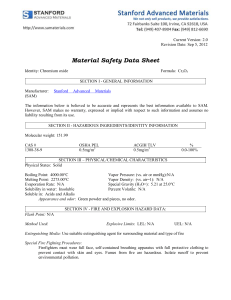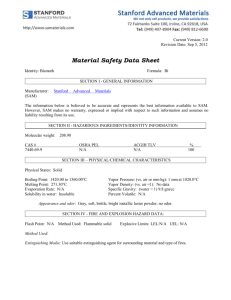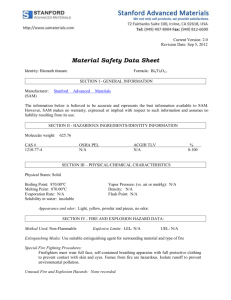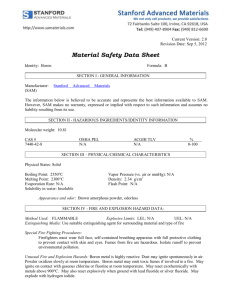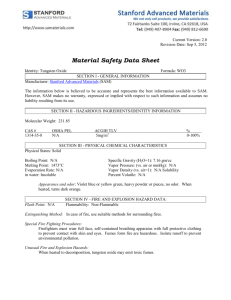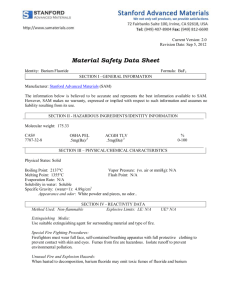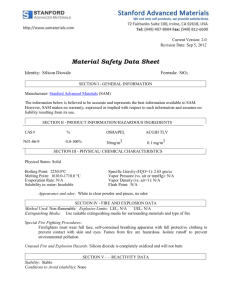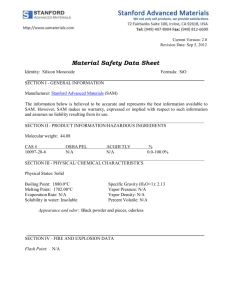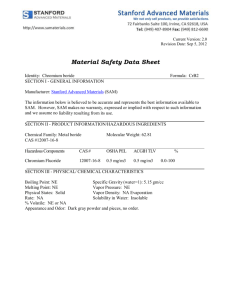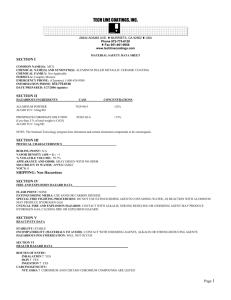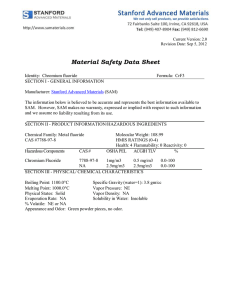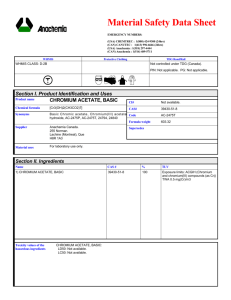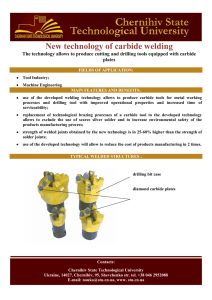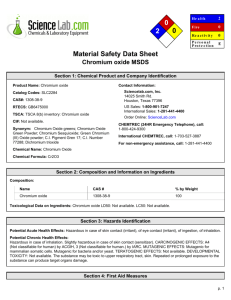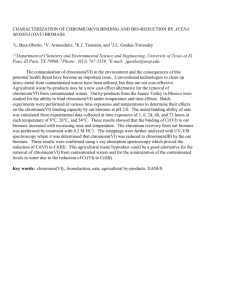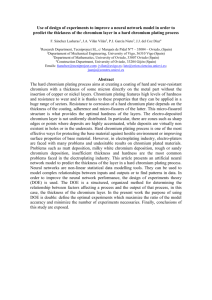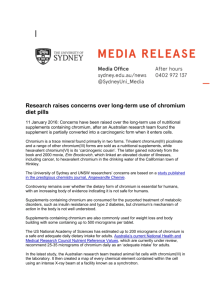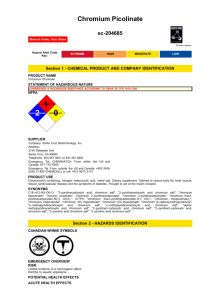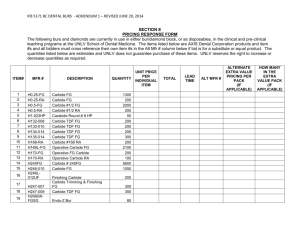Microsoft Word
advertisement
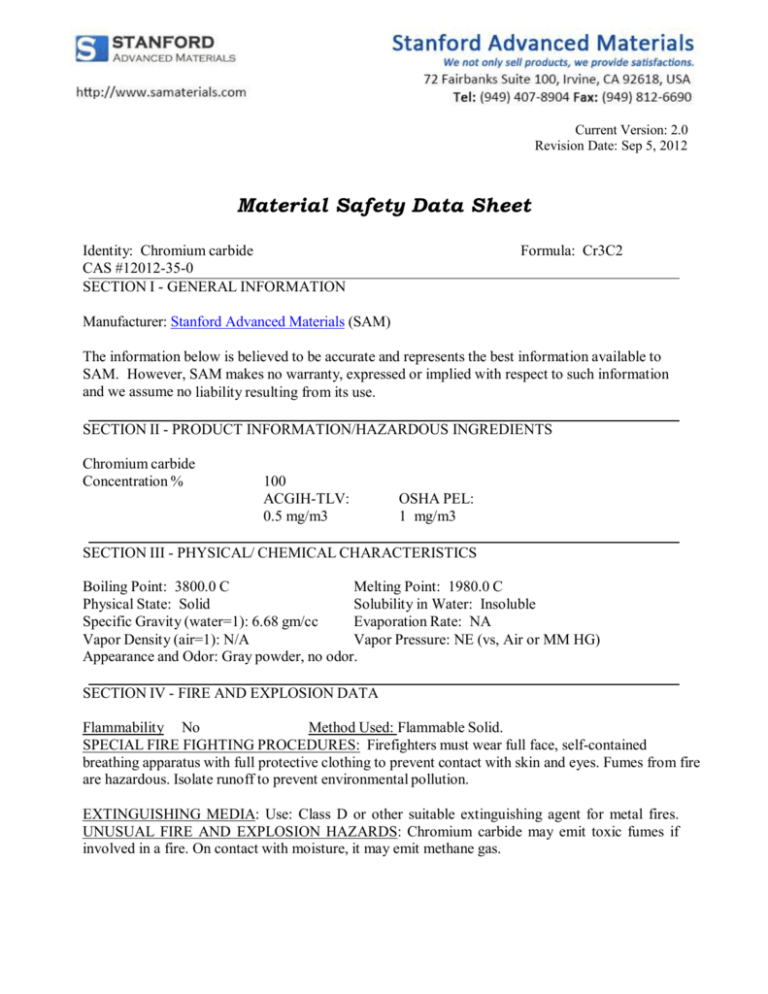
Current Version: 2.0 Revision Date: Sep 5, 2012 Material Safety Data Sheet Identity: Chromium carbide CAS #12012-35-0 SECTION I - GENERAL INFORMATION Formula: Cr3C2 Manufacturer: Stanford Advanced Materials (SAM) The information below is believed to be accurate and represents the best information available to SAM. However, SAM makes no warranty, expressed or implied with respect to such information and we assume no liability resulting from its use. SECTION II - PRODUCT INFORMATION/HAZARDOUS INGREDIENTS Chromium carbide Concentration % 100 ACGIH-TLV: 0.5 mg/m3 OSHA PEL: 1 mg/m3 SECTION III - PHYSICAL/ CHEMICAL CHARACTERISTICS Boiling Point: 3800.0 C Melting Point: 1980.0 C Physical State: Solid Solubility in Water: Insoluble Specific Gravity (water=1): 6.68 gm/cc Evaporation Rate: NA Vapor Density (air=1): N/A Vapor Pressure: NE (vs, Air or MM HG) Appearance and Odor: Gray powder, no odor. SECTION IV - FIRE AND EXPLOSION DATA Flammability No Method Used: Flammable Solid. SPECIAL FIRE FIGHTING PROCEDURES: Firefighters must wear full face, self-contained breathing apparatus with full protective clothing to prevent contact with skin and eyes. Fumes from fire are hazardous. Isolate runoff to prevent environmental pollution. EXTINGUISHING MEDIA: Use: Class D or other suitable extinguishing agent for metal fires. UNUSUAL FIRE AND EXPLOSION HAZARDS: Chromium carbide may emit toxic fumes if involved in a fire. On contact with moisture, it may emit methane gas. SECTION V - REACTIVITY DATA Stability: Yes Conditions to Avoid – Instability: None. Incompatibility - Materials to avoid: Moisture, strong oxidization agents, acids and bases Hazardous decomposition or byproducts: Methane gas. Hazardous polymerization: Will not occur. Conditions to avoid – Hazardous polymerization: None. SECTION VI - HEALTH HAZARD DATA Mode of Entry: Inhalation: Yes Skin: Yes Eyes: No Ingestion: No Carcinogenicity: NTP: No IARC: Yes OSHA: YES To the best of our knowledge the chemical, physical and toxicological properties of chromium carbide have not been thoroughly investigated and recorded. CHROMIUM: Confirmed human carcinogen with experimental tumorigenic data. Human poison by ingestion with gastrointestinal effects. (Sax, Dangerous Properties of Industrial Materials) INHALATION Acute: May cause irritation. Chronic: May cause pneumoconisis, histologic fibrosis of lungs, nasal and/or lung cancer INGESTION Acute: May cause gastrointestinal disorders. Chronic: No chronic health effects recorded. SKIN Acute: May cause irritation. Chronic: No chronic health effects recorded.. EYE Acute: May cause irritation. Chronic: May cause conjunctivitis. Target Organs: May affect the respiratory system. SIGNS AND SYMPTOMS OF EXPOSURE INHALATION: May cause a red dry throat, coughing and shortness of breath. INGESTION: May cause gastritis, convulsions, asphyxia, giddiness, nausea, diarrhea and vomiting. SKIN: May cause redness, and itching. EYE: May cause redness, and watering. EMERGENCY AND FIRST AID PROCEDURES INHALATION: remove victim to fresh air, keep warm and quiet, give oxygen if breathing is difficult and seek medical attention. INGESTION: Give 1-2 glasses of milk or water and induce vomiting, seek medical attention. Never induce vomiting or give anything by mouth to an unconscious person. SKIN: Remove contaminated clothing, brush material off skin, wash affected area with mild soap and water. Seek medical attention immediately. EYE: Flush eye with lukewarm water, lifting upper and lower eyelids for at least 15 minutes. Seek medical attention immediately SECTION VII – PRECAUTIONS FOR SAFE HANDLING Wear appropriate respiratory and protective equipment specified in section VIII. Isolate spill area and provide ventilation. Vacuum up spill using a high efficiency particulate absolute (HEPA) air filter and place in a closed container for proper disposal. Take care not to raise dust. Use non-sparking tools. Dispose of in accordance with local, state and federal regulations. Store in a cool, dry area, in tightly sealed container. Wash thoroughly after handling. Chromium carbide reacts with moisture to form methane gas. Handle and store in a controlled environment and inert gas such as argon. SECTION VIII – PROTECTIVE EQUIPMENT Respiratory: NIOSH – approved dust respirator. Gloves: Rubber gloves. Ventilation: To maintain concentration at or below the PEL, TLV SPECIAL: Handle in an enclosed, controlled environment. Mechanical (Gen): Not Recommended. Other: Handle in an inert gas such as argon. Eye and Skin Protection: Wear safety glasses, wear appropriate coveralls to prevent body or skin contact.
